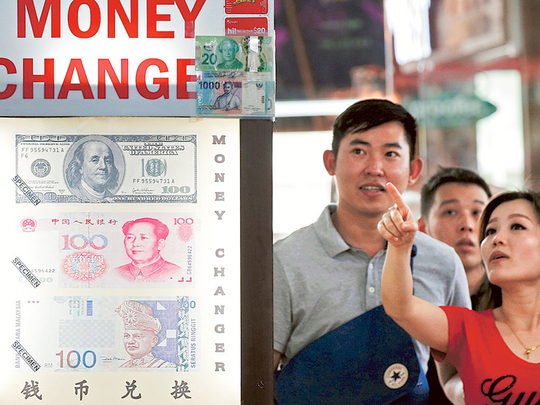
Frankfurt: The euro’s worst year in a decade is looking even grimmer after the Chinese yuan’s inclusion in the International Monetary Fund’s basket of reserve currencies.
The 19-nation currency’s weighting in the IMF’s Special Drawing Rights basket will drop to 30.93 per cent, from 37.4 per cent, the organisation said Monday. The yuan will join the dollar, euro, pound and yen in the SDR allocation from Oct. 1, 2016, at a 10.92 per cent weighting.
The euro has tumbled 13 per cent against the dollar this year, the most in a decade, and central banks have reduced the proportion of the currency in their reserves to the lowest since 2002. European Central Bank President Mario Draghi signalled on October 22 that policymakers are open to boosting stimulus, after embarking on a 1.1 trillion-euro ($1.2 trillion) asset-purchase program in March.
“The euro will get the most impact from this weight adjustment,” said Douglas Borthwick, head of foreign exchange at New York-based brokerage Chapdelaine & Co. “The IMF is taking from euro to give to China; the other rebalancing amounts are largely negligible.”
China’s currency will exceed yen and sterling in the new basket. The levels will be 41.73 per cent for the dollar, 8.33 per cent for the yen and 8.09 per cent for the pound, the IMF said. The dollar currently accounts for 41.9 per cent of the basket, while the pound accounts for 11.3 per cent and the yen 9.4 per cent.
International Credibility
It’s the first change in the SDR’s currency composition since 1999, when the euro replaced the Deutsche mark and French franc. It’s also a milestone in the yuan’s decades-long ascent toward international credibility. The currency was created after World War II and for years could be used only domestically in the Communist nation. The IMF reviews the composition of the basket every five years and rejected the yuan during the last review, in 2010.
“The more likely impact is on euro holdings as the yuan, over time, is seen as the main alternative reserve currency to the dollar, replacing the euro in that role,” said Mansoor Mohi- uddin, senior markets strategist at Royal Bank of Scotland Group Plc in Singapore. “Further, in 1999 when the euro was introduced, it still took reserve managers four years before they started diversifying into the single currency. So, we shouldn’t expect strong inflows into the yuan in the near term from risk-averse reserve managers.”
Worst performer
The euro has dropped 5.3 per cent this quarter against the dollar, the most among 10 developed-market peers. The shared currency was at $1.0586 as of 6:30am in London after reaching a seven-month low of $1.0558 on Monday. The yield on Germany’s two-year note was at minus 0.42 per cent Monday.
“I do not think it means central banks will decrease euro reserves dramatically near-term but the changes to the SDR and, perhaps, the prevalence of negative rates at the short-end of the euro rate curve more especially, suggests the euro may be less favoured among reserve-asset managers,” said Shaun Osborne, chief foreign-exchange strategist at Bank of Nova Scotia in Toronto.












